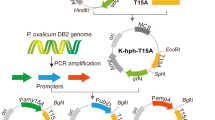Abstract
We describe here the use of sequences from the hydrophobin gene hcf-1 of Cladosporium fulvum to construct pCatBex, a vector for high-level expression and secretion of CatB, a catalase from Aspergillus nidulans. Transformation of C. fulvum with pCatBex results in a 60-fold increase in the mycelial activity in the fungus and the appearance of up to 5.4 mkat/l of catalase in the growth medium. The levels of catalase in the supernatant increased dramatically following removal of nitrogen from the medium. Conversely, the overall specific activity of catalase in the cytoplasm did not change appreciably. This indicates that nitrogen depletion induces greater secretion of protein. The vector pCatBex also directs the expression and secretion of CatB in Magnaporthe grisea and may be a useful vector for the expression of genes in other filamentous fungi.







Similar content being viewed by others
References
Aebi H (1984) Catalase in vitro. In: Colowick SP, Kaplan NO (eds) Methods in enzymology. Academic Press, London, pp 121–126
Bradford MM (1976) A rapid and sensitive method for the quantitation of microgram quantities of protein utilizing the principle of protein–dye binding. Anal Biochem 72:248–254
Bussink H-J, Oliver R (2001) Identification of two highly divergent catalases in the fungal tomato pathogen, Cladosporium fulvum. Eur J Biochem 267:1–11
Clare DA, Duong MN (1984) Effects of molecular oxygen on detection of superoxide radical with nitroblue tetrazolium and on activity stains for catalase. Anal Biochem 140:532–537
Conesa A, Punt PJ, Luijk N van, Hondel C van den (2001) The secretion pathway in filamentous fungi: a biotechnological view. Fungal Genet Biol 33:155–171
Fowler T, Rey MW, Vahavahe P, Power SD, Berka RM (1993) The CatR gene encoding a catalase from Aspergillus niger: primary structure and elevated expression through increased gene copy number and use of a strong promoter. Mol Microbiol 9:989–998
Fulton TM, Chunwongse J, Tanksley SD (1995) Microprep protocol for extraction of DNA from tomato and other herbaceous plants. Plant Mol Biol Rep 13:207–209
Gamborg OL, Miller RA, Ojima K (1968) Nutrient requirements of suspension cultures of soybean root cells. Exp Cell Res 50:148–151
Hamada W, Spanu P (1998) Cosuppression of the hydrophobin gene HCf-1 is correlated with antisense RNA biosynthesis in Cladosporium fulvum. Mol Gen Genet 259:630–638
Khalaj V, Bookman JL, Robson GD (2001) A study of the protein secretory pathway of Aspergillus niger using a glucoamylase–GFP fusion protein. Fungal Genet Biol 32:55–65
Nielsen H, Engelbrecht J, Brunak S, Heijne G von (1997) Identification of prokaryotic and eukaryotic signal peptides and prediction of their cleavage sites. Protein Eng 10:1–6
Oliver RP, et al (1987) Transformation of Fulvia fulva, a fungal pathogen of tomato, to hygromycin-b resistance. Curr Genet 12:231–233
Punt PJ, Oliver RP, Dingemanse MA, Pouwels PH, Hondel CAMJJ van den (1987) Transformation of Aspergillus based on the hygromycin-b resistance marker from Escherichia coli. Gene 56:117–124
Punt PJ, Biezen N van, Conesa A, Albers A, Magnus J, Hondel CAMJJ van den (2002) Filamentous fungi as cell factories for heterologous protein production. Trends Biotechnol 20:200–206
Radzio R, Kück U (1997) Synthesis of biotechnologically relevant heterologous proteins in filamentous fungi. Plant Mol Biol Rep
Sambrook J, Fritsch EF, Maniatis T (1987) Molecular cloning. Cold Spring Harbor Laboratory Press, Cold Spring Harbor, N.Y.
Segers GC, Hamada W, Oliver RP, Spanu PD (1999) Isolation and characterisation of five different hydrophobin-encoding cDNAs from the fungal tomato pathogen Cladosporium fulvum. Mol Gen Genet 261:644–652
Spanu P (1997) HCf-1, a hydrophobin from the tomato pathogen Cladosporium fulvum. Gene 193:89–96
Spanu P (1998) Deletion of HCf-1, a hydrophobin gene of Cladosporium fulvum, does not affect pathogenicity in tomato. Physiol Mol Plant Pathol 52:323–334
Talbot NJ, Ebbole DJ, Hamer JE (1993) Identification and characterization of MPG1, a gene involved in pathogenicity from the rice blast fungus Magnaporthe grisea. Plant Cell 5:1575–1590
Wessels JGH (2000) Hydrophobins, unique fungal proteins. Mycologist 14:153–159
Whiteford JR, Spanu PD (2001) The hydrophobin HCf-1 of Cladosporium fulvum is required for efficient water-mediated dispersal of conidia. Fungal Genet Biol 32:159–168
Whiteford JR, Spanu PD (2002) Hydrophobins and the interactions between fungi and plants. Mol Plant Pathol 3:391–400
Wösten HAB (2001) Hydrophobins: multipurpose proteins. Annu Rev Microbiol 55:625–646
Acknowledgements
We thank Julie Scholes and Nick Talbot for providing the strains of C. fulvum and M. grisea. H.J., J.W. and S.E. gratefully acknowledge financial support by the BBSRC.
Author information
Authors and Affiliations
Corresponding author
Additional information
Communicated by U. Kück
Rights and permissions
About this article
Cite this article
Johnson, H., Whiteford, J.R., Eckert, S.E. et al. Production and secretion of Aspergillus nidulans catalase B in filamentous fungi driven by the promoter and signal peptide of the Cladosporium fulvum hydrophobin gene hcf-1 . Curr Genet 44, 155–163 (2003). https://doi.org/10.1007/s00294-003-0421-4
Received:
Revised:
Accepted:
Published:
Issue Date:
DOI: https://doi.org/10.1007/s00294-003-0421-4




